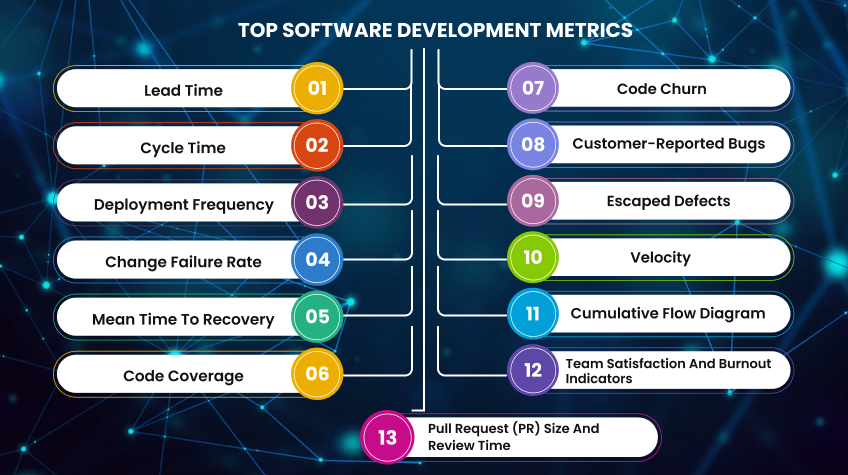
Innovation in today’s software development industry has become quite dynamic and when it comes to development and launch within the context of software applications, successful tracking of the perfect metrics is crucial. Metrics provide information related to the quality of code produced as well as the work performed by the team members and the reliability of the resulting system. Development teams can identify bottlenecks, optimize workflows, lower errors, and enhance the user experience by keeping an eye on these indications. This article highlights some of the top software development metrics and explains why these metrics are important to track.
List of the Top Software Development Metrics to Track
Identifying and tracking the right software development metrics is crucial to achieving software development goals focused on efficiency, quality, and time. Here are some of the top software development metrics that can provide valuable insights:
1. Lead Time
Lead Time measures the overall time it takes to get a request through to its final stage and deployment. Lead Time is used primarily in Agile and DevOps frameworks because it is focused on the development efficiency and the team’s performance in delivering features or fixes.
➢ Why Track It?
This suggests that shorter lead times mean that the development process is faster. It also gives an indication of the team’s ability to respond to new requirements.
2. Cycle Time
Cycle Time in the process of software development is the time needed to accomplish a given task once work on it starts up until the task is complete. While Lead Time is the total time taken from request to deliver. Cycle Time zeroes in on the working aspect of it, or how fast work items are turned from a state of ‘in progress’ to ‘complete.’
➢ Why Track It?
It enables one to see the specific points of a process where much time and effort can be saved or gained. It is often the case that shorter cycle times mean more productivity.
3. Deployment Frequency
Deployment Frequency is one of the DevOps and Agile metrics that imply a rate at which the development team deploys new code. It illustrates the frequency and tempo used in conveying new additions, fixing something, or adding features to the end-users and in direct correlation to meeting customers’ needs timely and addressing market dynamics.
➢ Why Track It?
Frequent deployment means that there is a seamless flow of creating and delivering new features and improvements. Agility and DevOps are also scaled with this index.
4. Change Failure Rate
The Change Failure Rate (CFR) is a development metric referring to the ratio of defective changes delivered to the production environment which might include bug, outage, and rollback situations. It accrues the stability of a team’s software releases, informing a team on the quality of codes released as well as the efficiency of testing, code review, and quality assurance processes.
➢ Why Track It?
Lower change failure rates point to a higher quality of development, fewer risks, and a better approach when it comes to testing.
5. Mean Time to Recovery

Mean Time to Recovery (MTTR) is another development metric, the average time it takes to get back on track after a failure has been noted in the production line. It comprises issue detection, mitigation, and the process of coming back to normal standard or functioning.
➢ Why Track It?
Shorter MTTR illustrates the team’s capability to address problems promptly as well as show system dependability.
6. Code Coverage
Code Coverage is a metric of the extent to which structure and statements in a given program are executed by a set of automatically generated tests. This quantifies the measure for code to a certain extent and is an indication of how comprehensive a test suite is. Code Coverage is fairly common in CI pipelines, especially when integrating new changes before deployment.
➢ Why Track It?
When developers achieve high code coverage, their applications are most likely to be bug-free or at least have few bugs. However, it should be noted that going straight for 100% is unwise, for while striving to achieve coverage, the speed of development, which is critical to development, may decrease without bringing as much value.
7. Code Churn

Code Churn is used to define the rates and volume of code changes within a particular code base in any dated period, usually as a measure of the differences in the number of line additions, modifications, or deletions. It represents the level of shakiness or rework in the development process because it predetermines how many times developers of the application revisit it and make changes.
➢ Why Track It?
A high churn rate may suggest unclear requirements or may point to the initially low production of high-quality code or problems with developers.
8. Customer-Reported Bugs
Customer Bug List is an essential parameter in software production that defines the number of bugs or complaints that customers provide after the production of the product or the release of a certain feature. This metric also includes information about product quality and customer feedback in addition to the quality of testing activities within the company.
➢ Why Track It?
It portrays how the end-user is feeling and also highlights areas that need to be enhanced. Few customer-reported bugs normally point towards stable software.
9. Escaped Defects
Escaped Defects are defects or bugs in software, which remain undiscovered during the development and testing phase and are discovered by users once the software product is live.
➢ Why Track It?
Rates above this level suggest issues with testing or code review.
10. Velocity
This metric sought to determine the number of tasks that a particular team accomplishes within one sprint usually in points of story or tasks.
➢ Why Track It?
Velocity can be useful for estimating the work to be done in the upcoming sprints and to determine the team’s throughput, but its use should be approached carefully as may easily result in burnout or low-quality work.
11. Cumulative Flow Diagram (CFD)
A Cumulative Flow Diagram (CFD) is a form of charting that graphs current work in various steps.
➢ Why Track It?
By using CFDs, developers can easily identify bottlenecks, and due to the visualization of the undertaking process, the workflow of tasks can be regulated making the management easy, and the development pipeline efficient.
12. Team Satisfaction and Burnout Indicators
It involves qualitative data acquired via engagement monitoring software or surveys.
➢ Why Track It?
Productivity and retention are positively correlated with high team satisfaction and low burnout rates. Better software is usually produced by content developers.
13. Pull Request (PR) Size and Review Time
Calculates how long it takes to review pull requests and their average size.
➢ Why Track It?
Long PRs can slow down development and increase errors, while smaller, more rapidly assessed pull requests frequently result in safer and faster deployments.
Also Read – Ways to Use AI in Software Development
Conclusion
In conclusion, software development metrics play an important role as development teams can advance in their work and achieve customer satisfaction on the result. The metrics outlined here like, lead time, cycle time, deployment frequency, and code coverage provide useful information about the teams and the health of the development cycle. Through the right choice of these indicators, it is possible not only to find weaknesses but also to improve work processes, ensuring awareness of the need for constant improvement.






